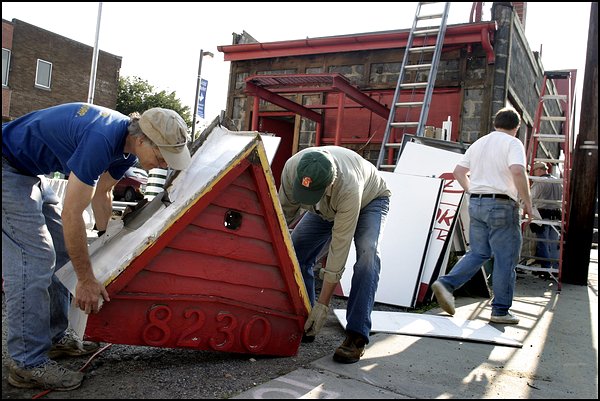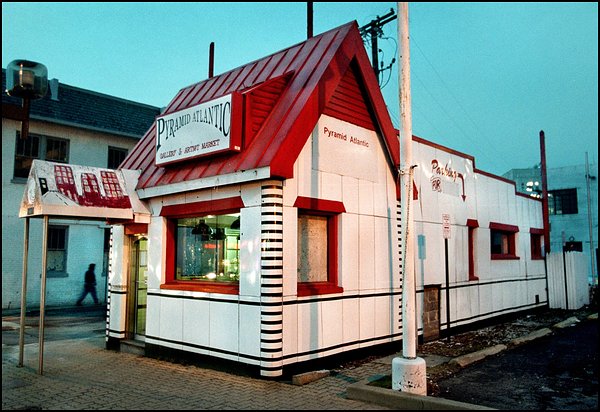Silver Spring Saves A Slice of History
Former Hamburger Stand Is Dismantled; Facade, Signage Preserved for Street Exhibit
By Garance Burke
Washington Post Staff Writer
Sunday, July 27, 2003; Page C06
As a local franchise of a vast burger empire, Silver Spring's Little Tavern was a haven for the hungry and the broke. Its chintzy, faux-Tudor facade and diminutive dinners drew generations of enthusiasts.
But yesterday morning, two construction workers suspended 15 feet in the air removed the tiny Georgia Avenue hamburger stand's signature green-and-white panels, one by one.
"It used to be, buy 'em by the bag; now it's, take 'em apart by the panel," said preservationist Tom Bertch, as he stood beneath the cherry picker while traffic sped past.
Last month, a controversy erupted between the Silver Spring Historical Society and Pyramid Atlantic, the arts organization that had applied for a permit to demolish the Little Tavern building, whose site is to become a community arts space. Members of the historical society protested plans to raze the building and applied to have the burger shop listed as a historic site -- a move rejected by Montgomery County officials in a July 9 vote.
Ultimately, it took just $3,500 to find a solution: That sum will pay the costs of moving the shell of the building to the National Capital Trolley Museum in Colesville. The museum stepped in last week to save the former tavern, which will become part of a permanent street exhibit.
Some surprises emerged yesterday as crews dismantled the building, which went through several incarnations after the Little Tavern shut in 1992.
Hidden under the siding were two original signs, remnants from a time when the midget hamburgers cost just 5 cents.
"Finding these pieces is like a real nice gift," said Wesley Paulson, the museum's director of development. "I've been wanting one of these for the museum for years. The Little Tavern is going to show you that there was more to the streetcar era than just riding the cars."
Moving the building also left the nonprofit arts organization satisfied.
"The trolley museum was the perfect receiver for the parts of the Little Tavern that the historical society was wishing could be exhibited," said Helen Frederick, Pyramid's executive director.
The burger shop, built in 1935 and once the flagship store in the Little Tavern chain, once appeared headed for official protection. In 1984, the Montgomery County Historic Preservation Commission placed the building on its locational atlas, a listing of sites eligible to be considered for historic designation. It was later removed, and in 1994 a counterpart in Bethesda was designated to be preserved because it was in better condition.
But even if the Georgia Avenue tavern got no official awards, it was clear that the building held meaning for those to whom its quirky presence became a landmark of daily life.
"It was like an anchor for the block. Whenever you said the Little Tavern in Silver Spring, people always knew where you were talking about," said Joy Doumas, 53, co-owner of Dale Music Co., which is two doors down from the tavern site. Doumas said one of the tavern's best customers was Norman Lane, a homeless man -- nicknamed the "Mayor of Silver Spring" -- who was so beloved that neighbors put up a bronze plaque in his honor in a vacant spot just across the street.
Others remembered the burger joint's place in their own history.
"If your date would say, 'Let's go someplace special tonight,' you'd say, 'Yeah, let's go to the Club L.T.,' " recalled George French, 56, who volunteered his morning to dismantle the restaurant's airplane-size chrome bathroom doors. "It's almost like an insult to the workmen and architects who came before us to take it down."
French and Bertch spent several days methodically stenciling labels on each of the 200 panels to be reassembled at the trolley car museum.
But not everyone appeared so sure that the Little Tavern should be held up to be admired. "If I walked into that Little Tavern when it first started up, I don't know if I would have been served -- and it wouldn't have been because I didn't have enough money," said project manager Curtis White, 48, who is African American. "I sat in the public hearing and I did wonder, What are you trying to preserve?"
© 2003 The Washington Post Company
I took offense to the last paragraph in the above article. The comment eerily echoed the same remark read by one of the Historic Preservation Commissioers in the form of a letter submitted to oppose designation of Little Tavern to the Locational Atlas & Index of Historic Sites. Below is the text of a letter which I submitted to the Washington Post, which was published on August 2, 2003, p. A19.:
Historic -- Warts and All (not my title!)
Garance Burke's decision to end her article on such an
incendiary note was both unfair to the Silver Spring
Historical Society's effort to save our community's
1940 Little Tavern Hamburger Shop as well as an insult
to historic preservationists everywhere ("Silver
Spring Saves A Slice of History," 7/27/03.)
Yes, Pyramid Atlantic's project manager Curtis White
may, as an African-American, experienced racism had he
patronized Little Tavern in its early years. Should
the past inequities that may or may not have been
embodied in this structure, or in any structure of
historic merit, serve as a litmus test for its
preservation?
By that reasoning the magnificent Spanish Ballroom,
located at the National Park Service's Glen
Echo Park, should never have been restored because of
its history of segregation. The adaptive reuse
currently in progress of downtown Washington's
original Hecht's Department Store, site of numerous
protests lead by activist Mary Church Terrell due to
the store's policy of segregated lunch counters,
should be immediately halted.
The list, unfortunately, could go on and on. To
equate the worthiness of historic preservation with
racism is simply short-sighted and wrong.
Jerry A. McCoy
President Silver Spring Historical Society



